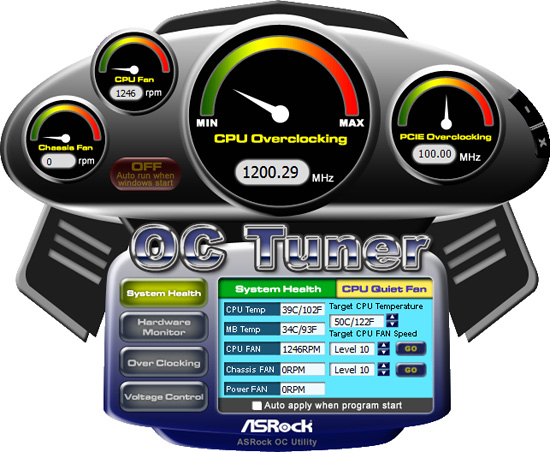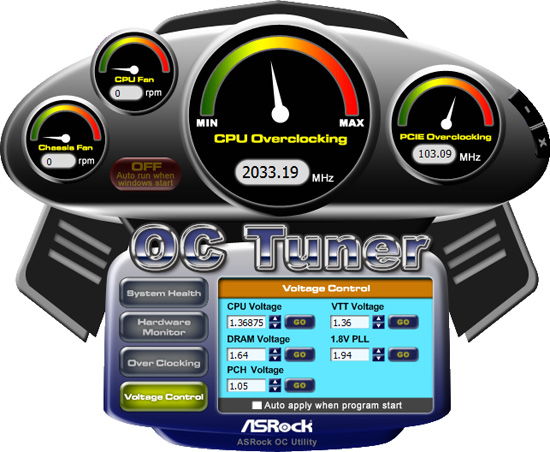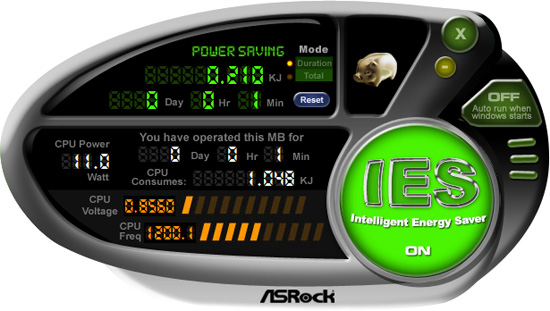Budget Micro-ATX P55 Faceoff: Gigabyte GA-P55M-UD2 and ASRock P55M Pro
by Gary Key on October 5, 2009 12:30 PM EST- Posted in
- Motherboards
Software
ASRock provides several software applications with the P55M Pro. We will take a quick look at their OC Tuner, Intelligent Energy Saver (IES), and OC DNA.
OC Tuner

ASRock’s OC Tuner application provides health and hardware monitoring, voltage control, and overclocking capabilities. OC Tuner is actually a solid Window’s based overclocking and monitor tool. We still want the ability to save the settings to the BIOS in real time - or at least a BIOS profile setup more robust than the OC DNA tool below. The version shipped on the driver CD worked correctly, but we always suggest you keep the supplier’s utilities up to date.

Sounding like a broken record, we still prefer to tune our system within the BIOS. However, this application is useful for extracting a decent amount of performance improvement out of the system after booting into Windows. We also found the capability to adjust the CPU and Chassis fan speeds to be handy during the overclocking tests.
OC DNA

The OC DNA application allows you to save your OC profiles to the three provided user profiles within the BIOS. You can then load them from Windows (requires a reboot to set the profile) or share the OC profile with users of this board.
IES

One of the most useful features from ASRock is their Intelligent Energy Saver (IES) power management solution. ASRock provides a Windows-based software application to control IES. After installing the software (we highly recommend downloading the latest version) and a quick reboot, the application is ready for use. The control panel is powered down by default and it is up to the user to turn it on with a simple click of the IES button. IES can also be enabled within the BIOS, doing this will disable Load Line Calibration (No Vdrop).
The IES software is simple to use and easy to understand. A provided power savings meter in the top portion informs the user of current and historical power savings information. Real-time CPU power usage is available along with the processor speed. We generally found the application would save around 4W at idle, and depending up the application in use, around 20W under load conditions that leads to superb results compared to other P55 boards.










55 Comments
View All Comments
goinginstyle - Monday, October 5, 2009 - link
I loved the review also and it showed a lot of work went into testing these boards. I just wonder when TA152H is going to ruin this thread but until then it nice to see constructive posts. I also wish the mobo guys would just drop the floppy and IDE ports when possible. It would free up board real estate and hopefully drop the cost a little more.papapapapapapapababy - Monday, October 5, 2009 - link
not touching any of this at least it has Socket 775 mounting holesusb3 @ pci3 @sata6 and im there.
Docket - Monday, October 5, 2009 - link
It is a shame that there are no Linux versions of the Gigabyte software reviewed here... oh well maybe some day in a distant future.mitt - Monday, October 5, 2009 - link
Hallelujah! DPC latency benchmark in AnandTech reviews!mathew7 - Monday, October 5, 2009 - link
When MB manufacturers are going to let go of PCI?I recently switched to Micro-ATX, and found I have a real problem of choosing a motherboard.
I'm looking at buying a PCIe X-Fi, but would like to use a dual-slotted video card. But I would like to keep my options open for a second card (I'm htinking about physics, not SLI/CF, so dual-slot cooling is not required). While the Gigabyte does not pass my requirements, the Asrock also has a problem: usage of a dual-slot-cooled card inhibits the usage of the PCIex1 slot.
I intend to switch to i5/P55 at the start of next year, so I'm watching closely.
Jaybus - Thursday, October 8, 2009 - link
That will be a slow transition. There are still a lot of PCI adapters being sold out there, especially for some specialty markets like scientific instrumentation that take time to transition to new interfaces due to cost and low volume. Nevertheless, the demise of PCI is starting to happen. For most people it's not a big deal, because they only need 1 or 2 PCIe x16 slots for graphics cards and will never use the rest of the slots anyway.MadMan007 - Monday, October 5, 2009 - link
Kind of funny but Intel is leading the pack in that specific area, their $200 (ugh) 'Extreme' DP55SB mATX P55 mobo has no PCI slots, also no PS/2, IDE or floppy. Maybe it's consistent since they ditched PS/2 and other legacy connectors on some boards a while back. No telling on the overclocking front but it is an 'extreme' board so it may have at elast some overclocking features. It has a couple of neat features actually, Bluetooth and Intel NIC.Jaybus - Thursday, October 8, 2009 - link
And uATX is a good platform to remove PCI from. Why not drop it from uATX? They can always leave it on ATX boards for a while for those who absolutely need PCI slots. I think other manufacturers will follow that path very soon.MadMan007 - Monday, October 5, 2009 - link
*bzzt* The only PCIe 2.0 lanes on a P55 platform are from the CPU. So look carefully at specs and double check with companies when they say their secondary slots, especially ones that aren't even 16x mechanical, are PCIe 2.0. The UD2's 4x electrical slot in particular is clearly not according to Gigabyte, the ASRock claims to be but I'm not sure how if all 16 CPU PCIe 2.0 lanes are used for the graphics slot. If they used a lane splitter to provide PCIe 2.0 lanes to the other slots it kind of defeats the purpose, and if so it would be good to check performance with those slots populated.MadMan007 - Monday, October 5, 2009 - link
To follow up on this, the comment was based on the first few paragraphs. I looked over Intel's manual for their 'extreme' mATX board for my post about it and Intel actually states their mobo has PCIe 2.0 lanes to the additional PCIe slots. Not surprising for the 8x slot I guess but it is for the 1x slots and it seems unlikely Intel would misquote specs.On a related note there is one thing I've not seen yet from any review and that is how PCIe lanes get assigned, mainly to the primary 16x slot, when populating a secondary PCIe slot with a 1x or 4x card. Do the lane splitter chips assign 8x lanes to a secondary slot which has a 1x or 4x card or what? Not a huge deal but it's a little thing that would be nice to know.